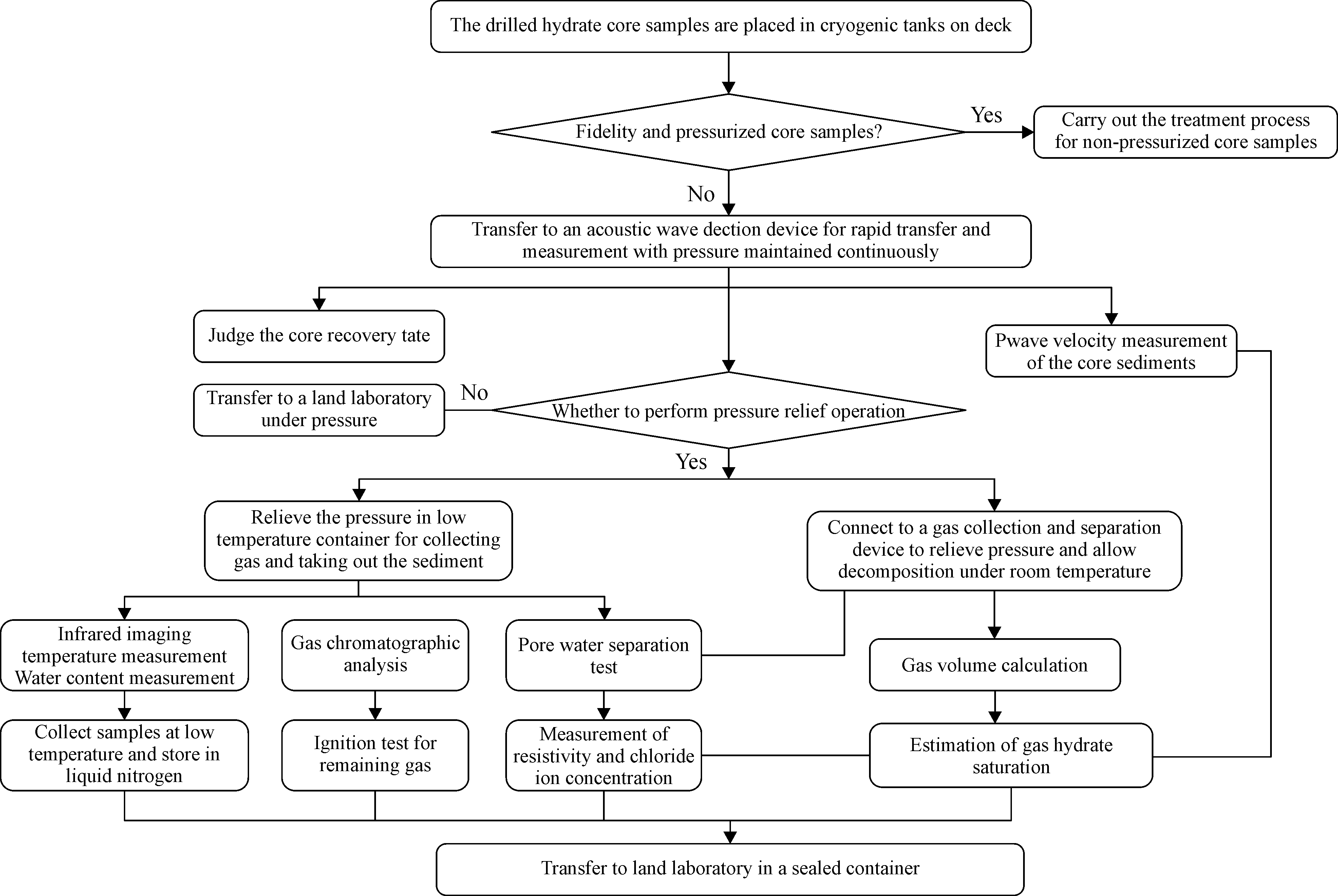

Analysis of physical properties of gas hydrate-bearing unconsolidated sediment samples from the ultra-deepwater area in the South China Sea
Received date: 25 Jan 2021
Accepted date: 29 Jul 2021
Published date: 15 Jun 2022
Copyright
Marine natural gas hydrate has recently attracted global attention as a potential new clean energy source. Laboratory measurements of various physical properties of gas hydrate-bearing marine sediments can provide valuable information for developing efficient and safe extraction technology of natural gas hydrates. This study presents comprehensive measurement results and analysis of drilled hydrate-bearing sediments samples recovered from Qiongdongnan Basin in the South China Sea. The results show that the gas hydrate in the core samples is mainly methane hydrate with a methane content of approximately 95%, and the other components are ethane and carbon dioxide. The saturation of the samples fluctuates from 2%–60%, the porosity is approximately 38%–43%, and the water content is approximately 30%–50%, which indicate that high water saturation means that timely drainage should be paid attention to during hydrate extraction. In addition, the median diameter of the sediment samples is mainly distributed in the range of 15 to 34 μm, and attention should be paid to the prevention and control of sand production in the mining process. Moreover, the thermal conductivity is distributed in the range of 0.75 to 0.96 W/(m∙K) as measured by the flat plate heat source method. The relatively low thermal conductivity of hydrates at this study site indicates that a combined approach is encouraged for natural gas production technologies. It is also found that clay flakes and fine particles are attached to the surface of large particles in large numbers. Such characteristics will lead to insufficient permeability during the production process.

Xin LYU , Qingping LI , Yang GE , Min OUYANG , Hexing LIU , Qiang FU , Junlong ZHU , Shouwei ZHOU . Analysis of physical properties of gas hydrate-bearing unconsolidated sediment samples from the ultra-deepwater area in the South China Sea[J]. Frontiers in Energy, 2022 , 16(3) : 509 -520 . DOI: 10.1007/s11708-021-0786-4
| 1 |
Sloan E D Jr. Fundamental principles and applications of natural gas hydrates. Nature, 2003, 426(6964): 353–359
|
| 2 |
Milkov A V. Global estimates of hydrate-bound gas in marine sediments: how much is really out there? Earth-Science Reviews, 2004, 66(3–4): 183–197
|
| 3 |
Zhao J, Liu Y, Guo X,
|
| 4 |
Gao Q, Yin Z, Zhao J,
|
| 5 |
Liang H, Yang L, Song Y,
|
| 6 |
Zhao J, Guo X, Sun M,
|
| 7 |
Zhou S, Li Q, Lv X,
|
| 8 |
Lee J H, Baek Y S, Ryu B J,
|
| 9 |
Wu S, Zhang G, Huang Y,
|
| 10 |
Zhang Z, McConnell D R, Han D. Rock physics-based seismic trace analysis of unconsolidated sediments containing gas hydrate and free gas in Green Canyon 955, Northern Gulf of Mexico. Marine and Petroleum Geology, 2012, 34(1): 119–133
|
| 11 |
Lu Y, Luan X, Lyu F,
|
| 12 |
Kuang Y, Yang L, Li Q,
|
| 13 |
Liu C, Ye Y, Meng Q,
|
| 14 |
Liu C, Meng Q, He X,
|
| 15 |
Guo X, Xu L, Wang B,
|
| 16 |
Liu C, Meng Q, Hu G,
|
| 17 |
Yang L, Falenty A, Chaouachi M,
|
| 18 |
Kneafsey T J, Lu H, Winters W,
|
| 19 |
Lee J Y, Kim G Y, Kang N K,
|
| 20 |
Chong Z, Zhao J, Chan J H R,
|
| 21 |
Chong Z, Moh J W R, Yin Z,
|
| 22 |
Song Y, Kuang Y, Fan Z,
|
| 23 |
Wang L, Sun X, Shen S,
|
| 24 |
Wang L, Li Y, Wu P,
|
| 25 |
Lee C, Yun T S, Lee J S,
|
| 26 |
Pooladi-Darvish M, Hong H. Effect of conductive and convective heat flow on gas production from natural hydrates by depressurization. In: Taylor C E, Kwan J T, eds. Advances in the Study of Gas Hydrates. Boston: Springer, 2004
|
| 27 |
Yang L, Zhao J, Wang B,
|
| 28 |
Wang B, Fan Z, Lv P,
|
| 29 |
Liu Y, Zhang L, Yang L,
|
| 30 |
Zhao J, Liu Y, Yang L,
|
| 31 |
Lu S, McMechan G A. Estimation of gas hydrate and free gas saturation, concentration, and distribution from seismic data. Geophysics, 2002, 67(2): 582–593
|
| 32 |
Waite W F, Santamarina J C, Cortes D D,
|
| 33 |
Gustafsson S E, Karawacki E, Khan M N. Transient hot-strip method for simultaneously measuring thermal conductivity and thermal diffusivity of solids and fluids. Journal of Physics D, Applied Physics, 1979, 12(9): 1411–1421
|
| 34 |
Kim Y G, Lee S M, Matsubayashi O. New heat flow measurements in the Ulleung Basin, East Sea (Sea of Japan): relationship to local BSR depth, and implications for regional heat flow distribution. Geo-Marine Letters, 2010, 30(6): 595–603
|
| 35 |
Yang L, Ai L, Xue K,
|
| 36 |
Gao Q, Zhao J, Yin Z,
|
| 37 |
Gao Q, Zhao J, Yin Z,
|
| 38 |
Lyu X, Li Q, Ge Y,
|
/
| 〈 |
|
〉 |